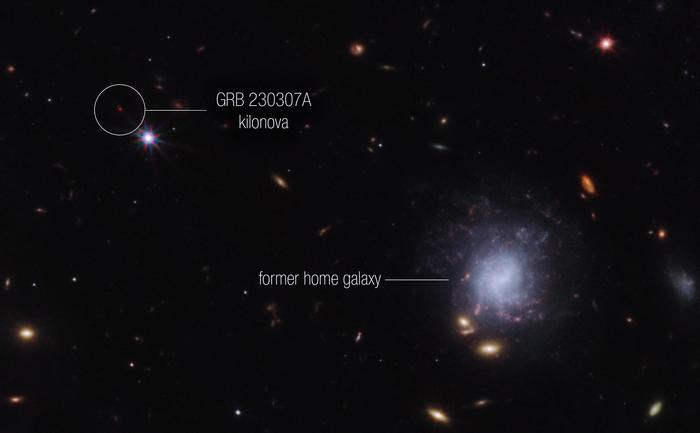Scientists have observed the creation of rare chemical elements in the second-brightest gamma-ray burst ever seen – casting new light on how heavy elements are made.
Researchers examined the exceptionally bright gamma-ray burst GRB 230307A, which was caused by a neutron star merger. The explosion was observed using an array of ground and space-based telescopes, including NASA’s James Webb Space Telescope, Fermi Gamma-ray Space Telescope, and Neil Gehrels Swift Observatory.
Publishing their findings today in Nature (25 Oct), the international research team which included experts from the University of Birmingham, reveal that they found the heavy chemical element tellurium, in the aftermath of the explosion.

Other elements such as iodine and thorium, which are needed to sustain life on earth, are also likely to be amongst the material ejected by the explosion, also known as a kilonova.
Dr Ben Gompertz, ᴀssistant Professor of Astronomy at the University of Birmingham, and co-author of the study explains: “Gamma-ray bursts come from powerful jets travelling at almost the speed of light – in this case driven by a collision between two neutron stars. These stars spent several billion years spiralling towards one another before colliding to produce the gamma-ray burst we observed in March this year. The merger site is the approximate length of the Milky Way (about 120,000 light-years) outside of their home galaxy, meaning they must have been launched out together.
“Colliding neutron stars provide the conditions needed to synthesise very heavy elements, and the radioactive glow of these new elements powered the kilonova we detected as the blast faded. Kilonovae are extremely rare and very difficult to observe and study, which is why this discovery is so exciting.”
GRB 230307A was one of the brightest gamma-ray bursts ever observed – over a million times brighter than the entire Milky Way Galaxy combined. This is the second time individual heavy elements have been detected using spectroscopic observations after a neutron star merger, providing invaluable insight into how these vital building blocks needed for life are formed.
Lead author of the study Andrew Levan, Professor of Astrophysics at Radboud University in the Netherlands, said: “Just over 150 years since Dmitri Mendeleev wrote down the periodic table of elements, we are now finally in the position to start filling in those last blanks of understanding where everything was made, thanks to the James Webb Telescope.”
GRB 230307A lasted for 200 seconds, meaning it is categorised as a long-duration gamma-ray burst. This is unusual as short gamma-ray bursts, which last less than two seconds, are more commonly caused by neutron star mergers. Long gamma-ray bursts like this one are usually caused by the explosive death of a mᴀssive star.
The researchers are now seeking to learn more about how these neutron star mergers work and how they power these huge element-generating explosions.
Dr Samantha Oates, a co-author of the study while a postdoctoral research fellow at the University of Birmingham (now a lecturer at Lancaster University) said: “Just a few short years ago discoveries like this one would not have been possible, but thanks to the James Webb Space Telescope we can observe these mergers in exquisite detail.”
Dr Gompertz concludes: “Until recently, we didn’t think mergers could power gamma-ray bursts for more than two seconds. Our next job is to find more of these long-lived mergers and develop a better understanding of what drives them – and whether even heavier elements are being created. This discovery has opened the door to a transformative understanding of our universe and how it works.”
Reference:
Levan, A., Gompertz, B.P., Salafia, O.S. et al. Heavy element production in a compact object merger observed by JWST. Nature (2023). DOI: 10.1038/s41586-023-06759-1





